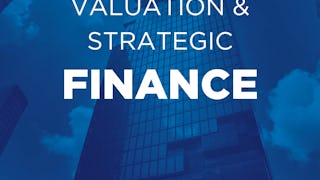In this course, participants will develop an understanding of the intuitive foundations of asset and investment valuation, and how alternative valuation techniques may be used in practice. This is part of a Specialization in corporate finance created in partnership between the University of Melbourne and Bank of New York Mellon (BNY Mellon).



Alternative Approaches to Valuation and Investment
This course is part of Essentials of Corporate Finance Specialization


Instructors: Paul Kofman
18,440 already enrolled
Included with
(314 reviews)
Skills you'll gain
Details to know

Add to your LinkedIn profile
See how employees at top companies are mastering in-demand skills

Build your subject-matter expertise
- Learn new concepts from industry experts
- Gain a foundational understanding of a subject or tool
- Develop job-relevant skills with hands-on projects
- Earn a shareable career certificate

There are 4 modules in this course
This week we will define a statistical measure of stand-alone risk as being the standard deviation of returns. We will describe three alternative attitudes towards risk, settling on risk aversion as being the standard assumption made in financial markets. We will then analyse the impact of combining assets into a portfolio upon both risk and return and then quantify the benefits from diversification by comparing performance against a suitable benchmark.
What's included
6 videos7 readings2 assignments
This week we differentiate between systematic and unsystematic risk and explain how the expected returns that are reflected in the prices of assets should be linked to only one type of risk. We illustrate how the Capital Asset Pricing Model might be used to link systematic risk with expected return and then discuss the empirical shortcomings of the model. This leads to a description of more advanced models and we conclude with a review of survey evidence that considers the approach taken by finance mangers of large listed firms in practice.
What's included
7 videos1 reading2 assignments
This week we will explain the logical underpinnings of the Weighted Average Cost of Capital Formula and show how it might be estimated in practice by a firm. We will also consider the many challenges that might be faced in using this approach to estimating hurdle rates and conclude with a warning about the perverse outcomes that might occur if the technique is used in a haphazard manner.
What's included
5 videos1 reading2 assignments
This week we describe how standard NPV analysis might lead to incorrect decisions when we fail to account for the impact of (or upon) firm flexibility. We then describe the three most common types of real options that firms face in practice and then explain how decision trees might be used to arrive at an approximation of the value of the real option that is embedded within a project. We conclude by considering empirical evidence on the take-up of real options analysis and discuss the situations in which real options analysis might most be needed.
What's included
5 videos4 readings3 assignments1 peer review
Earn a career certificate
Add this credential to your LinkedIn profile, resume, or CV. Share it on social media and in your performance review.
Instructors

Offered by
Explore more from Finance
 Status: Free Trial
Status: Free TrialThe University of Melbourne
 Status: Free Trial
Status: Free TrialUniversity of Illinois Urbana-Champaign
 Status: Free Trial
Status: Free TrialFundação Instituto de Administração
 Status: Free Trial
Status: Free TrialThe University of Melbourne
Why people choose Coursera for their career




Learner reviews
314 reviews
- 5 stars
77.35%
- 4 stars
17.92%
- 3 stars
3.45%
- 2 stars
0.31%
- 1 star
0.94%
Showing 3 of 314
Reviewed on Mar 7, 2020
Very good for refreshing basic investment theory & some exercises with real numbers. Nice literature is available
Reviewed on Oct 7, 2017
A truly enjoyable course from start to finish! An excellent accompaniment to any aspiring portfolio manager
Reviewed on Dec 27, 2015
Excellent series of courses. Wish I had done a specialization and had more time to do a better job.Perhaps I will do the Capstone project.

Open new doors with Coursera Plus
Unlimited access to 10,000+ world-class courses, hands-on projects, and job-ready certificate programs - all included in your subscription
Advance your career with an online degree
Earn a degree from world-class universities - 100% online
Join over 3,400 global companies that choose Coursera for Business
Upskill your employees to excel in the digital economy
Frequently asked questions
To access the course materials, assignments and to earn a Certificate, you will need to purchase the Certificate experience when you enroll in a course. You can try a Free Trial instead, or apply for Financial Aid. The course may offer 'Full Course, No Certificate' instead. This option lets you see all course materials, submit required assessments, and get a final grade. This also means that you will not be able to purchase a Certificate experience.
When you enroll in the course, you get access to all of the courses in the Specialization, and you earn a certificate when you complete the work. Your electronic Certificate will be added to your Accomplishments page - from there, you can print your Certificate or add it to your LinkedIn profile.
Yes. In select learning programs, you can apply for financial aid or a scholarship if you can’t afford the enrollment fee. If fin aid or scholarship is available for your learning program selection, you’ll find a link to apply on the description page.
More questions
Financial aid available,
¹ Some assignments in this course are AI-graded. For these assignments, your data will be used in accordance with Coursera's Privacy Notice.

